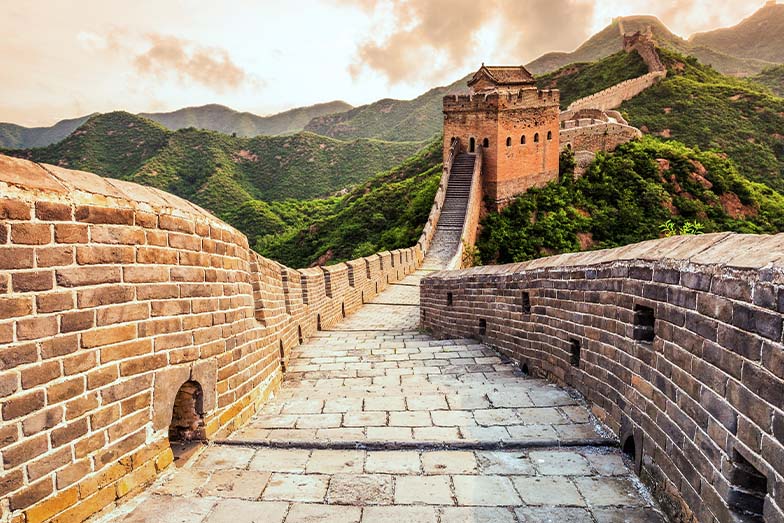About the Great Wall of China

Built to fortify China’s northern border, the Great Wall consists of walls, fortresses and passes, as well as horse tracks, watchtowers and shelters. While not entirely effective at preventing incursions, this UNESCO World Heritage Site is considered, according to UNESCO, to “provide significant physical evidence of the far-sighted political strategic thinking and mighty military and national defense forces of central empires in ancient China”, and “reflects collision and exchanges between agricultural civilizations and nomadic civilizations in ancient China”.
Age of the Great Wall of China
According to historians, the Great Wall was continuously built from the third century BCE to the seventeenth century CE. The first sections of the massive structure were the defensive walls, erected between 770-476 BC (the ‘Spring and Autumn Period’) and 475-221 BC (referred to as the ‘Warring States Period’). The Great Wall has a history dating back three thousand years.
Length of the Great Wall of China
According to Encyclopedia Britannica, the total length of all sections of the Great Wall of China ever built adds up to about 21,196 kilometers (13,171 miles), including overlapping sections that were rebuilt. The wall constructed during the Ming dynasty, the most well-preserved section, is about 8,850 kilometers (5,499 miles) long.
Is the Great Wall of China visible from space?
The claim that the Great Wall of China can be seen from space is something of a myth. Astronauts have stated that the Great Wall cannot be seen from the moon with the naked eye. However, under ideal visibility conditions, the Great Wall can be observed from low Earth orbit and from the International Space Station.
History of the Great Wall of China

Construction of the Great Wall began in the seventh century BCE and was continued by successive dynasties, with a large portion of the Wall erected around the end of the third century BCE, during the Qin Dynasty. It is believed that Emperor Qin Shi Huang expanded the Great Wall by connecting its various sections.
The majority of today’s Great Wall was built during the Ming Dynasty. The Ming government repaired and expanded the structure in order to protect its northern borders and repel nomadic tribes. Following the fall of the Ming Dynasty, the Great Wall was severely worn and in need of repair. Several sections were repaired during and after the Qing Dynasty (1644-1912). However, widespread neglect and natural erosion have left many sections of the Great Wall in ruins.
People who lost their lives during the construction of the Great Wall
The answer to the question, “How many people died during the construction of the Great Wall?” is inconclusive. The Great Wall took centuries to build and the empire was ruled by different dynasties during those periods; thus there are no consistent records indicating worker casualties. However, according to various historians, several million people perished in the overall process of building the Great Wall.
From the 20th century to today
The Great Wall of China was well-maintained throughout the twentieth century and governments continue to work to preserve this historical structure. Sections of the Great Wall have become highly popular tourist destinations. If seeing the Great Wall of China is one of your travel goals, keep in mind that Turkish Airlines operates direct flights to Beijing, one of the world’s oldest capitals. You can book a flight to Beijing today!
Which parts of the Great Wall are open to tourists?
Sections of the Great Wall in and around Beijing are accessible to visitors, with Mutianyu, Badaling and Jinshanling the most popular sites for tourists. You can visit these three locations to learn about the history of the Great Wall, observe its architectural features up close and experience its unique landscape.
Badaling
Badaling is one of the most visited and well-known sections of the Great Wall. Located northwest of Beijing, Badaling is extremely popular among tourists and visitors due to the site’s accessibility and preserved condition.
Mutianyu
Though relatively less crowded than Badaling, Mutianyu is another popular section along the Great Wall. Northeast of Beijing, Mutianyu offers particularly scenic views and is easily accessible via cable car or other vehicles.
Jinshanling
Located east of Beijing, the Jinshanling section stands out for its surrounding natural beauty. Set on steep slopes, Jinshanling is considered an ideal trekking destination due to its numerous hiking trails and a popular area for photographers due to its breathtaking scenery!
Simatai
The Simatai section, near Jinshanling, offers visitors a glimpse of the Great Wall preserved in its original form. However, tourist facilities around Simatai are limited compared to other locations.

